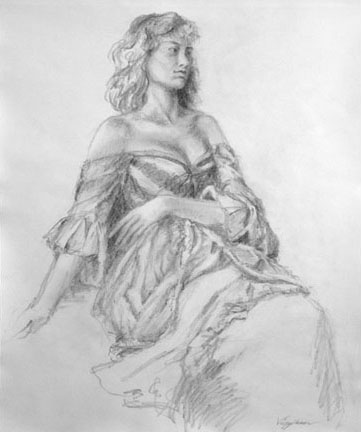Drawing Technique Explained
Drawing is an age-old art form, and could be considered the most basic and fundamental expression of visual art. It requires no more than a hard object, and a surface to be inscribed by that object, to produce a drawing. There’s something satisfyingly simple about that. Yet, as we can see from the caliber of work some artists produce in our era, this seemingly basic form of expression is virtually limitless in the degree of quality and sophistication to which it can be taken. Combine that with the vast array of drawing media we have at our disposal, and there’s enough inspiration to keep an artist busy for a lifetime, without ever picking up a tube of paint!

There are many drawing techniques taught at art school and they can take years to master. But to bring out a few points of interest, let’s look at the drawing above and discuss a few of the methods employed in this figure portrait.
Charcoal is a medium which works well for rapid sketching. I like it because one can achieve a good diversity of lights and darks without the dark areas becoming shiny, as they might if graphite pencils were being used. Incidentally, I prefer using charcoal in pencil form, rather than the big, rectangular, woodless variety.
Some basic drawing terms include “line,” “shape,” and “form.” These are essentially artistic permutations of geometry. Line is the simplest element of drawing, but critically important. In the figure above, we can see the outlines going around the woman and all the drapery she’s wearing. But they aren’t just solid, straight, continuous lines like a computer might generate. They vary in thickness and lightness. Some are very clean lines and others more sketchy. All of this serves to describe the subject matter in a way that makes her appear both natural and realistic, as well as interesting to look at from an aesthetic standpoint. Imagine if I’d only used a solid, unchanging line throughout the whole drawing. Boring, right?
The term “shape” is pretty self explanatory. When a line goes around a certain area, say, the model’s hair for example, that creates a shape. Shapes in a drawing fit together like pieces in a puzzle. They can be simple shapes, or serve as parts in a complex system used to define form.
That brings us to the final term, “form.” Form means a three-dimensional object. To make a drawing appear realistic, form is almost always a necessary element. There are several techniques used in Days of Yore to describe the forms in the picture. Perhaps the most recognizable is shading. When an artist looks at a subject, he or she needs to use blending techniques, or “shading,” on the drawing to try and imitate the effects of light falling on the subject.
A less talked about, but no less effective, technique for giving the illusion of form involves the use of patterns (such as stripes), laying over the forms being depicted, fooling the eye into thinking those forms are really there in the drawing. In the image above, the stripes on the blouse, and even the folds on the sleeves, are curving in such a way that, collectively, they make it appear as though they’re following the undulations of the human form underneath. To get an idea of how effective this technique can be, imagine a drawing of a zebra, showing nothing at all except for the black stripes. With no shading, outlines, or other details, anyone looking at such a drawing would not only know it was a zebra, but, if the stripes were drawn accurately, could also perceive a fairly detailed three-dimensional depiction of the animal.
A third, and more subtile, method of suggesting form is the use of line. Yep, it’s full circle here. Variations in the thickness and lightness of lines, including outlines, actually helps specific areas of a drawing seem to come forward or recede in space. Additionally, when used throughout a drawing, these variations help bring an overall sense of dimension to the composition as a whole which, without such variations, would tend to appear flat.
So there we have it! Certainly, there’s more to drawing than just line, shape, and form. But, as evidenced by this article (which only scratches the surface) even these foundational principles can be complex topics in their own right. It’s good to remember though that, while it can be fun to analyze the construction of a drawing, the decisions an artist makes in creating a work, especially from a live subject, are very often made “on the fly,” using hard-earned intuition, rather than carefully calculated prior analysis.
